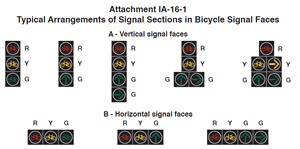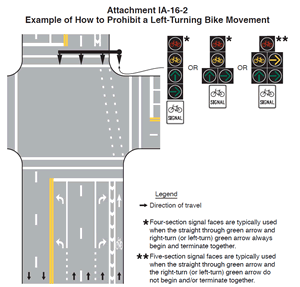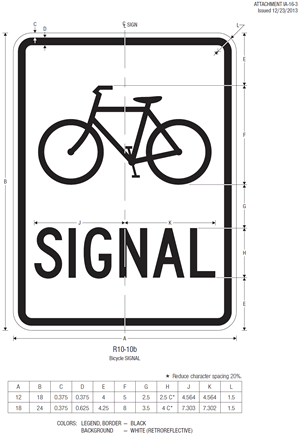| FHWA Policy Memorandums |
 |
PDF Version Letter, 729KB
PDF Version Attachments, 382KB
PDF files can be viewed with the Acrobat® Reader®
Memorandum |
|
| U.S. Department of Transportation | |
| Federal Highway Administration | |
| Subject: | INFORMATION:
MUTCD – Interim Approval for Optional Use of a Bicycle Signal Face (IA-16) |
Date: | December 24, 2013 |
| From: | Jeffrey A. Lindley Associate Administrator for Operations |
In Reply Refer To: | HOTO-1 |
| To: |
Federal Lands Highway Division Engineers Division Administrators |
Purpose: The purpose of this memorandum is to issue an Interim Approval for the optional use of bicycle signal faces. Interim Approval allows interim use, pending official rulemaking, of a new traffic control device, a revision to the application or manner of use of an existing traffic control device, or a provision not specifically described in the Manual on Uniform Traffic Control Devices for Streets and Highways (MUTCD).
All numerical or alpha-numeric references to Figures, Groups, Paragraphs, Parts, or Sections herein refer to the 2009 edition of the MUTCD.
Background: Part 9, Traffic Control for Bicycle Facilities, does not provide for bicycle signal faces. Part 4, Highway Traffic Signals, contains provisions to provide circular signal indications to control bikeways or bicycle movements (see Item F in Paragraph 3 of Section 4D.07). There are no provisions in the 2009 MUTCD that prohibit arrow signal indications from also being used to control bikeways or bicycle movements. However, bicycle signal faces that contain bicycle symbols are not mentioned in the 2009 MUTCD, and Paragraph 1 of Section 4D.06 provides that each signal indication (except for pedestrian signal heads and lane-use control signals) shall be circular or arrow.
The bicycle signal face described in this Interim Approval memorandum is a new traffic control device to the MUTCD and has only been used in the United States on an experimental basis through the MUTCD's experimentation process, which is described in Section 1A.10.
Research on Bicycle Signal Faces: Agencies across the United States are showing an increased interest in bicycle signal faces, and many of them have submitted requests to the Federal Highway Administration (FHWA) to experiment with bicycle signal faces. During the past 5 years, the FHWA has approved experiments with bicycle signal faces for a variety of State, county and local governmental agencies, including the following: the City of Denver, CO; the City of Long Beach, CA; the City of Washington, D.C.; the City of Minneapolis, MN; the City of Alexandria, VA; the County of Arlington, VA; the City of Madison, WI; the Oregon Department of Transportation; the County of Clackamas, OR; the City of Canton, OH; the City of Sparks, NV; the City of Chicago, IL; the City of Lakeland, FL; and the City of Ithaca, NY.
In these experiments, the bicycle signal face is a traffic control device that is being used to provide for separate control of the bicycle movement and address one or more of the following situations:
Research by governmental agencies internationally and also by academic institutions in the United States has also been performed on the operation of bicycle signal faces. These efforts include the Transportation Association of Canada, the Oregon Transportation Research and Education Consortium, and the City of Toronto, Ontario. Results by these organizations have been consistent with the findings of official experiments approved by the FHWA.
FHWA Evaluation of Results: The Office of Transportation Operations has reviewed the available data and considers the experimental bicycle signal face to be satisfactorily successful for the bicycle applications that were tested. Positive operational effects have been documented in the experiments such as a discernible and earlier behavioral adjustment(s) to newly installed bicycle traffic signals and traffic patterns as opposed to other devices, thereby resulting in an increased compliance by bicyclists with the traffic control. Additionally, depending on the specific application of the bicycle signal face, the research and experiments have shown that bicycle signal faces can provide an opportunity to either reduce the overall number of bicycle crashes, or reduce the bicycle crash rate up to 45 percent where bicycle volumes concurrently increase.
The design of the experimental bicycle signal face is not proprietary and can be used by any jurisdiction that requests and obtains approval from the FHWA to use bicycle signal faces in accordance with Paragraphs 14 through 22 of Section 1A.10. The FHWA believes that the experimental bicycle signal face has a low risk of safety or operational concerns.
This Interim Approval does not create a new mandate compelling the use of bicycle signal faces, but will allow agencies to install bicycle signal faces, pending official MUTCD rulemaking, to control bicycle movements at various locations and conditions.
While circular traffic signal indications can be used to control and facilitate bicycle movements as provided in Part 4, consideration should be given to any policy that uses the bicycle signal face to control specific bicycle movements. Agencies should exercise consistency with the decision to introduce bicycle signal faces to a roadway or bikeway network and use caution with any non-systematic policy to use bicycle signal faces because the intermixing of bicycle traffic signal faces and circular traffic signal indications to control bicycle movements in the same corridor or jurisdiction could create comprehension issues by the roadway user or violate bicyclist expectation.
Conditions of Interim Approval: The FHWA will grant permission for the optional use of bicycle signal faces under this Interim Approval to any jurisdiction that submits a written request to the Office of Transportation Operations. A State may request Interim Approval for all jurisdictions in that State. Jurisdictions seeking permission to use bicycle signal faces under this Interim Approval must agree to:
- A steady RED BICYCLE signal indication shall be displayed when it is intended to prohibit bicycle traffic from entering the intersection or other controlled area. Turning after stopping is permitted as stated in Item C.1 in Paragraph 3 of Section 4D.04, except that bicyclists positioned to the left of adjacent motor vehicle traffic on the same approach shall be prohibited from turning right on red, and bicyclists positioned to the right of adjacent motor vehicle traffic on the same approach shall be prohibited from turning left on red.
- A steady YELLOW BICYCLE signal indication shall be displayed following a GREEN BICYCLE signal indication or a GREEN ARROW in the same signal face. It shall not be displayed in conjunction with the change from the RED BICYCLE signal indication to a green signal indication. The YELLOW BICYCLE indication shall be followed by a RED BICYCLE signal indication.
- A steady GREEN BICYCLE signal indication shall be displayed only when it is intended to permit bicyclists to proceed in any direction that is lawful and practical, provided that the bicyclists are not in conflict with any simultaneous motor vehicle movements at the signalized location, including right (or left) turns on red, and further provided that the bicycle movement is not modified by lane-use signs, turn prohibition signs, pavement markings, separate turn signal indications, or other traffic control devices.
- Layout: The layouts and arrangements of the bicycle signal face (see Attachment IA-16-1) shall be in accordance with the following provisions:
- Only the bicycle symbol shown on Page 6-7 in the 2004 Standard Highway Signs book is to be used for bicycle signal indications. The symbol shall only be positioned horizontally and shall face to the left.
- Bicycle signal faces may be oriented vertically or horizontally. The RED BICYCLE, YELLOW BICYCLE, and GREEN BICYCLE signal indications shall be in the same relative position to each other as specified for the CIRCULAR RED, CIRCULAR YELLOW, and CIRCULAR GREEN signal indications for motor vehicles, respectively, in Sections 4D.09 and 4D.10.
- Circular signal indications and bicycle signal indications shall not be used on the same traffic signal face.
- Arrow signal indications and bicycle signal indications may be used on the same traffic signal face.
- As a specific exception to Paragraph 5 of Section 4D.09, two YELLOW BICYCLE signal indications or two GREEN BICYCLE signal indications shall not be arranged horizontally adjacent to each other at right angles to the basic vertical arrangement to form a clustered signal face.
- Single sections for continuous movements that would implement the bicycle symbol as illustrated in Group C of Figure 4D-2 shall not be used.
- Size: The provisions of Section 4D.07 apply to the sizes of bicycle signal faces except as follows:
- There shall be three nominal diameter sizes for bicycle signal indications: 4 inches, 8 inches, and 12 inches. The bicycle symbol used for bicycle signal indications shall be proportioned to fit within the signal lens.
- All signal indications in a bicycle signal face shall be of the same size, including both signal indications that display arrows and signal indications that display bicycle symbols. As a specific exception to Paragraph 2 in Section 4D.07, 4-inch and 8-inch arrow signal indications may be used in bicycle signal faces.
- Four-inch signal indications shall only be used in supplemental, post-mounted, near-side bicycle signal faces. If used, 4-inch signal indications may exclude the accompanying visor(s) and backplate. Near-side bicycle signal faces may alternatively be either 8-inch or 12-inch.
- Placement: The provisions of Sections 4D.13 through 4D.16 apply to the placement of the bicycle signal faces except as follows:
- As a specific exception to Item A in Paragraph 1 of Section 4D.11, a minimum of one primary bicycle signal face shall be provided traffic control for the bicycle movement, even if a bicycle through movement exists.
- The primary bicycle signal face shall have either 8-inch or 12-inch signal indications, even if it is located at the near side of the signal-controlled location.
- When the primary bicycle signal face is located more than 120 feet from beyond the stop line, a supplemental near-side bicycle signal face shall be provided.
- When the primary bicycle signal face is located more than 80 feet from beyond the stop line, a supplemental near-side bicycle signal face should be provided.
- Bicycle signal faces should be placed such that visibility is maximized for bicyclists and minimized for adjacent or conflicting motor vehicle movements. In cases where motor vehicle drivers might be confused by viewing the bicycle signal indications, such as when the start or end of a green bicycle signal indication occurs at a different time than the start or end of a green signal indication for a concurrent adjacent motor vehicle movement, consideration should be given to using visibility-limited bicycle signal faces. If visibility-limited bicycle signal faces are used, the signal faces shall be adjusted so that bicyclists for whom the indications are intended can see the signal indications.
- A bicycle signal face should be separated vertically or horizontally from the nearest motor vehicle traffic signal face for the same approach by at least 3 feet.
- Mounting Height: The provisions of Section 4D.15 apply to the mounting height of bicycle signal faces except as follows:
- The bottom of the signal housing (including brackets) of a bicycle signal face that is not located over a roadway shall be a minimum of 7 feet above the sidewalk or ground, except where supplemental signing is installed below the bicycle signal face. If supplemental signing is installed below the bicycle signal face, the minimum mounting height to the bottom of the supplemental sign shall be 6 feet. If the bottom of the supplemental sign is mounted less than 7 feet above a pedestrian sidewalk or pathway, the supplemental sign shall not project more than 4 inches into the pedestrian facility.
- If 4-inch signal indications are used in a supplemental, post-mounted, near-side bicycle signal face, the bottom of the signal housing (including brackets) shall be a minimum of 4 feet and a maximum of 8 feet above the sidewalk or ground.
- Intensity and Light Distribution: Except for the 4-inch nominal size of the lens diameter, the intensity and distribution of light from each illuminated bicycle signal face should be similar to that recommended for vehicular traffic signal faces in accordance with Paragraph 10 of Section 4D.06 to the extent practicable.
- Backplates: Backplates may be used with bicycle signal faces. If used, ancillary legends of any kind that identify the purpose or operation of the bicycle signal face shall not be placed on the backplate.
- Mode: The mode of operation of the bicycle signal faces shall be the same as the mode for the operation traffic signal faces for motor vehicle traffic. Bicycle signal faces shall operate in the steady (stop-and-go) mode when traffic signal faces for motor vehicle traffic are operating in the steady (stop-and-go) mode. Bicycle signal faces shall operate in the flashing mode when the signal faces for motor vehicles are operating in the flashing mode, whether programmed or due to a malfunction. Bicycle signal faces shall not be placed in a dark mode when the traffic signal faces for motor vehicle traffic are operating in the flashing mode.
- Timing: The provisions of Section 4D.26 apply to the duration of the yellow change and the red clearance intervals of a bicycle signal phase except as follows:
- The minimum duration of the yellow change interval shall be 3 seconds.
- The maximum duration of the yellow change interval should be 6 seconds. The exclusive function of the yellow change interval shall be to warn bicyclists approaching a signalized location that their permission to proceed is being terminated after which they will be directed to stop. Providing enough clearance time for a bicyclist to travel through the intersection or conflict area is the purpose of the red clearance interval, not of the yellow change interval.
- If discernible non-concurrent activations or terminations of phases for motorized vehicular traffic and bicycle signal indications are necessary, visibility-limiting devices should be used on the bicycle signal face.
- Turning Movements: The following provisions apply to turning movements for bicyclists:
- In cases where it is necessary to prohibit certain turning movements by bicyclists because of a conflict with motor vehicles moving concurrently from an adjacent lane(s), the bicycle signal face shall use a combination of red and yellow bicycle symbol (or arrow) signal indications and green arrow signal indications. Examples of typical bicycle signal face arrangements for accomplishing turn prohibitions are shown in Attachment IA-16-2.
In the presence of a bicycle signal face, the prohibition of bicycle turning movements shall not solely be through the use of movement prohibition signs (see Section 2B.18), modifications thereof, or through the use of plaques that supplement movement prohibition signs.- As a specific exception to Paragraph 11 of Section 4D.05, the simultaneous display of a straight-through GREEN ARROW signal indication in a bicycle signal face and a CIRCULAR RED signal indication in a motor vehicle signal face for the same approach shall be permitted. If the green arrows in the bicycle signal face can be seen by motor vehicle drivers in the adjacent lane(s), consideration should be given to using visibility-limited bicycle signal faces.
- Pedestrian Hybrid Beacons: Bicycle signal faces shall not be used in any manner with respect to the design and operation of a pedestrian hybrid beacon.
- Shared Lane Markings Only: Bicycle signal faces shall not be used for controlling any bicycle movement that is sharing a lane with motor vehicle traffic.
- Exclusive Bicycle Phases that permit "Scramble" Phases: Bicycle signal faces shall not be used to provide a bicycle phase that stops all motorized vehicles and pedestrians at the signalized location in order to allow multiple bicycle movements from multiple conflicting directions.
Any questions concerning this Interim Approval should be directed to Mr. Kevin Dunn at kevin.dunn@dot.gov.
Attachment(s)
cc:
Associate Administrators
Chief Counsel
Chief Financial Officer
Directors of Field Services
Director of Technical Services
Attachment(s) PDF Version, 379KB



Long Description of Interim Approval for Optional Use of a Bicycle Signal Face (IA-16) Images
|
United States Department of Transportation - Federal Highway Administration |
||